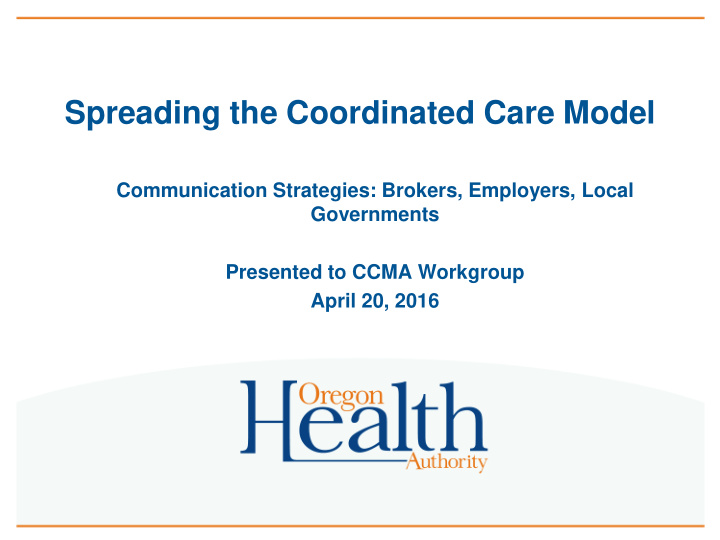



Spreading the Coordinated Care Model Communication Strategies: Brokers, Employers, Local Governments Presented to CCMA Workgroup April 20, 2016
Communication research and strategy • Question: How to spread CCM in commercial market? • Research – Workshop with CCMAW – Executive interviews – Focus groups with brokers, employers, employees • Plans and tools to leverage strongest opportunities – Brokers and employers consider CCM plans – Local Govts join PEBB/OEBB 2
BROKER AND EMPLOYER ENGAGEMENT PLAN 3
Recap of key research findings • Current perceptions among brokers and employers – “ Coordinated care (model) ” is understood but not commonly used – Most known element = coordination between providers, medical home – Other elements are appealing; facts and tangible examples are needed to overcome skepticism – Negative association with HMOs and Oregon Health Plan (OHP) but seen as more flexible • Appeal – Interest in learning more, especially as cost-saving approach – Audiences priority: #1 Brokers, #2 employers (employees unlikely to seek out or request but will consider if offered) 4
Recap of key research findings (cont.) • Key message points – Affordability (but must reassure that this does not mean poor quality) – Patient/provider relationship is highly valued; messages cannot appear to question or undermine – Include information on specific plans (rather than just a model) • Getting the word out – Brokers want the toolkit, want to control information (knowledge = asset) – Employers want the toolkit, prefer interactive sessions – OHA is trusted third-party messenger (as long as language and examples are business-relevant) 5
Engagement plan: Goal More Oregonians are covered by health plans that include elements of coordinated care, because private sector employers and the brokers who work with them seek out and choose these plans 6
Measurable outcomes • More small and mid-sized employers across the state offer their employees a coordinated care plan option • More large, self-insured employers across the state integrate some or all CCM elements in their health insurance plan designs • Down the road, depending on what strategies are implemented: o Brokers and employers request and use the CCMAW toolkit o Brokers participate in trainings and use information provided by OHA with their clients 7
Strategy 1: Resources to motivate action • Develop communication toolkits for brokers and employers cover letter talking points fact sheet with infographic frequently asked questions checklist explaining how to identify or find a coordinated care plan business-focused case studies and proof points • Create an online resource — easily accessible, business-focused 8
Strategy 2: Raise awareness and interest • Engage brokers and employers through trusted organizations and associations • Work with carriers to integrate coordinated care into broker presentations • Engage early champions as advocates to their peers • Conduct a road show in priority locations across the state • Consider media opportunities 9
Strategy 3: Continuing engagement and education • Stay connected with advocates and interested parties – Proactively follow-up with those who sign up and download toolkits – Send quarterly email updates • Provide continuing education – Create a continuing education module on coordinated care – Provide webinars on major updates to CCM on an ad hoc basis 10
PEBB AND OEBB FOR LOCAL GOVERNMENTS 11
Research • Interviews with local government entities and PEBB/OEBB staff • Focus group with prospective local government entities • Current entities – 100% would recommend to others – Key appeals: stability, buying power, admin support • Prospective entities – Largely unaware of opportunity – As they learn more, similar appeals to current entities – Deal breaker: Statute limiting leaving Board and requiring Marketplace • Clarity needed about requirement for governments with 51+ employees 12
Key messages • The opportunity: – Recognizing the benefit to Oregonians, employers, and our health care system of bringing more people into this stable insurance pool, the state has opened PEBB and OEBB to local governments – Provides opportunity to provide high quality insurance plans to employees while reducing risk, gaining buying power as part of a larger pool, and decreasing time spent on benefits administration 13
Key messages (cont.) • Benefits – Robust package of core and optional benefits – Large, stable pools – Benefits administration support • Details to answer questions, concerns – Clarify differences between PEBB/OEBB, how to choose – Clarify why governments may leave only once – Make actual costs transparent and easily accessible – Clarify the availability of plans in certain areas of the state – Compare rate increases inside and outside – Indicate the ability to cover employees in various positions 14
Call to action • Have questions? – Contact PEBB and OEBB to discuss options – Invite PEBB and OEBB to present – Conduct a non-binding assessment to determine rates and fees • Ready to join? – Assess your timeline – Write a letter of intent – Call PEBB and OEBB for help 15
Next steps • Final messages • Engagement plan for local governments • Communication toolkit for local governments – OEBB already using draft overview 16
Recommend
More recommend